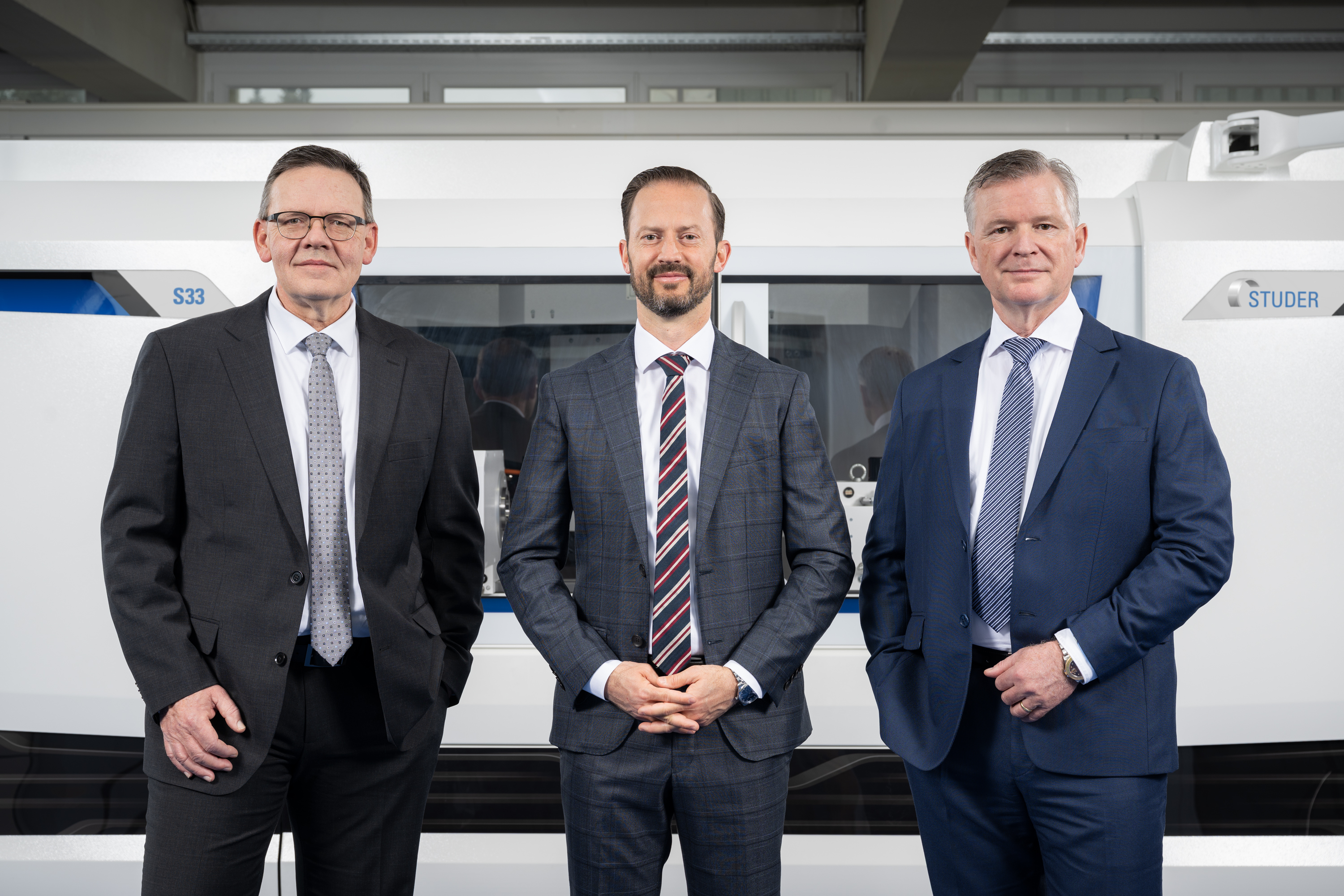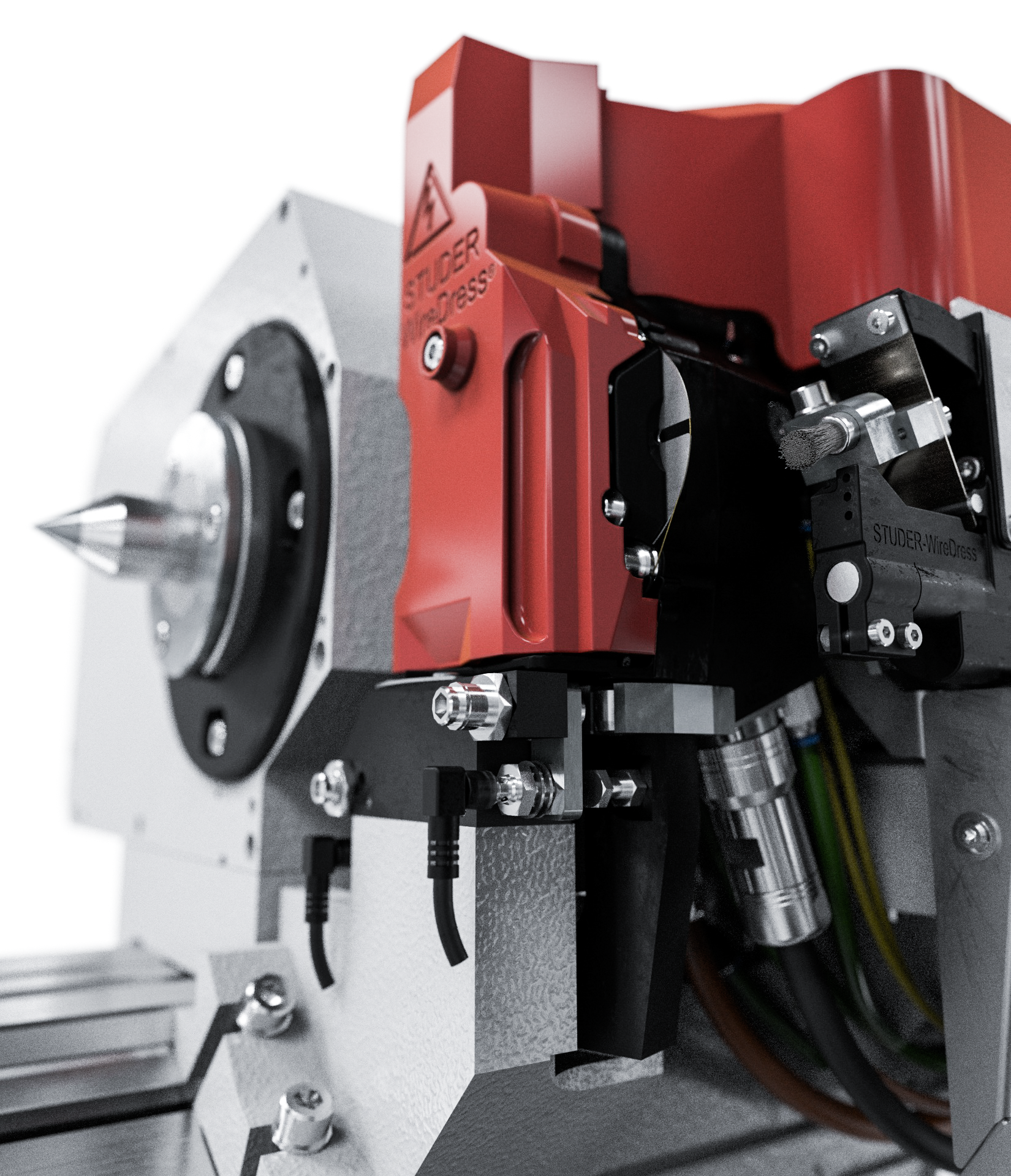
To share its 2024 sales results, 2025 expectations, and new product offerings with international trade media, Fritz Studer AG held its annual press conference on March 27. The event was streamed from the company’s in-house studio at its headquarters in Steffisburg, Switzerland.
“Thanks to the high diversification of our portfolio, we can look back on a solid financial year in 2024, with growth across several markets and industries,” said Jens Bleher, who has served as CEO of Studer since 2018. Effective April 1, Bleher joined the management board of the United Grinding Group as COO. Longtime Chief Sales Officer Sandro Bottazzo has taken over as the new CEO of Studer.
Bleher acknowledged that navigating the challenging economic and geopolitical environment required intense effort. “In addition to ensuring quality, we have focused on increasing productivity, managing costs intensively, and introducing innovative technologies,” he said. “Studer remains a reliable partner for our customers and is well-positioned to face global competition.”
Thanks to its strong market position, Bleher noted, Studer sees promising developments in several regions for 2025.
According to Bottazzo, Studer maintained its global market share and even expanded it in some regions. “We are continuing to strengthen our leadership in the universal cylindrical grinding machine market, step by step,” he said.
Customer development also proved strong, with a year-over-year increase of approximately 43%. Key growth areas included the Asian automotive and supplier industries, tool and die, and the broader machine tool sector. Studer also continued its expansion in aerospace, building on momentum from the previous year. While overall order intake was slightly below the previous year—as anticipated due to market conditions—North America saw particularly strong growth. Asia remained the company’s largest sales region, and Latin America, Northern Europe, and Eastern Europe also posted solid results. In contrast, Central Europe—especially Germany—fell short of expectations.
The Customer Care division achieved record sales in 2024, Bottazzo noted. The continued expansion of international, multilingual support teams and decentralized service specialists contributed significantly to this success. Strong performance was recorded in spare parts sales, maintenance, machine overhauls, and conversions. Service operations maintained a high level of capacity utilization throughout the year.
Studer credits its broad product portfolio as a key contributor to its continued success. The CNC universal cylindrical grinding machine segment led the way, with the S33 being the top-selling machine, followed by the S31 and favoritCNC. Sales of the premium S41 were also solid. Internal cylindrical grinding machines performed strongly as the second-best segment, while sales of production and conventional machines lagged behind expectations.
Innovation remained a core focus throughout 2024, according to CTO Daniel Huber. A key development project was the next-generation favoritCNC, which now features the latest Fanuc controls and a new “Conventional Mode.” This mode allows operators to work as they would on a traditional grinding machine, simplifying the transition to CNC operation.
Another technological advancement is a new universal W-axis for the S33 and S31. Integrated onto the Z-slide, the W-axis enables the automatic grinding of different workpiece lengths without operator intervention. The system includes a tailstock with a fixed center and a tailstock spindle with a driven center.
Huber also celebrated the growing success of the SmartJet coolant concept. In 2024, its applications expanded further to include thread grinding optimizations and plug-in coolant nozzles for various grinding wheel profiles. Additional advancements were made in Studer’s WireDress dressing process, designed for metal-bonded CBN and diamond grinding wheels. “We’ve now further developed WireDress to enable dressing of internal grinding wheels,” Huber said, noting that this makes it possible to dress both internal and external wheels in a single setup using this non-contact technology.

Another significant milestone was the full conversion of Studer’s relevant CNC platforms to the C.O.R.E. (Customer Oriented REvolution) system—United Grinding Group’s advanced hardware and software architecture. “C.O.R.E. is revolutionizing how grinding and machine tools operate,” Huber said, noting the system sets the foundation for continued software and feature development.
Studer COO Stephan Stoll provided an update on the Operations division. Despite a tense market environment, Studer’s manufacturing and assembly resources remained largely utilized—driven by its own machine business, internal group projects, and forward-looking prototype development.
The company also completed a full renewal of its internal electrical pre-assembly. “We can now produce everything from custom cable sets to fully wired, complex control cabinets—efficiently, order-specific, and just-in-time,” Stoll said.
Sustainability was another major area of focus. In 2024, Studer continued to enhance the energy efficiency of its operations by switching to LED lighting and upgrading supply systems to the latest generation of eco-friendly devices. The company’s new logistics facility is also expected to significantly reduce energy consumption.
Bleher concluded by highlighting the critical role of highly trained and motivated employees in Studer’s long-term success. “We are fully committed to vocational training. More than 11% of our workforce are apprentices,” he said.
Contact Details
Related Glossary Terms
- computer numerical control ( CNC)
computer numerical control ( CNC)
Microprocessor-based controller dedicated to a machine tool that permits the creation or modification of parts. Programmed numerical control activates the machine’s servos and spindle drives and controls the various machining operations. See DNC, direct numerical control; NC, numerical control.
- coolant
coolant
Fluid that reduces temperature buildup at the tool/workpiece interface during machining. Normally takes the form of a liquid such as soluble or chemical mixtures (semisynthetic, synthetic) but can be pressurized air or other gas. Because of water’s ability to absorb great quantities of heat, it is widely used as a coolant and vehicle for various cutting compounds, with the water-to-compound ratio varying with the machining task. See cutting fluid; semisynthetic cutting fluid; soluble-oil cutting fluid; synthetic cutting fluid.
- cubic boron nitride ( CBN)
cubic boron nitride ( CBN)
Crystal manufactured from boron nitride under high pressure and temperature. Used to cut hard-to-machine ferrous and nickel-base materials up to 70 HRC. Second hardest material after diamond. See superabrasive tools.
- cylindrical grinding
cylindrical grinding
Grinding operation in which the workpiece is rotated around a fixed axis while the grinding wheel is fed into the outside surface in controlled relation to the axis of rotation. The workpiece is usually cylindrical, but it may be tapered or curvilinear in profile. See centerless grinding; grinding.
- dressing
dressing
Removal of undesirable materials from “loaded” grinding wheels using a single- or multi-point diamond or other tool. The process also exposes unused, sharp abrasive points. See loading; truing.
- grinding
grinding
Machining operation in which material is removed from the workpiece by a powered abrasive wheel, stone, belt, paste, sheet, compound, slurry, etc. Takes various forms: surface grinding (creates flat and/or squared surfaces); cylindrical grinding (for external cylindrical and tapered shapes, fillets, undercuts, etc.); centerless grinding; chamfering; thread and form grinding; tool and cutter grinding; offhand grinding; lapping and polishing (grinding with extremely fine grits to create ultrasmooth surfaces); honing; and disc grinding.
- grinding machine
grinding machine
Powers a grinding wheel or other abrasive tool for the purpose of removing metal and finishing workpieces to close tolerances. Provides smooth, square, parallel and accurate workpiece surfaces. When ultrasmooth surfaces and finishes on the order of microns are required, lapping and honing machines (precision grinders that run abrasives with extremely fine, uniform grits) are used. In its “finishing” role, the grinder is perhaps the most widely used machine tool. Various styles are available: bench and pedestal grinders for sharpening lathe bits and drills; surface grinders for producing square, parallel, smooth and accurate parts; cylindrical and centerless grinders; center-hole grinders; form grinders; facemill and endmill grinders; gear-cutting grinders; jig grinders; abrasive belt (backstand, swing-frame, belt-roll) grinders; tool and cutter grinders for sharpening and resharpening cutting tools; carbide grinders; hand-held die grinders; and abrasive cutoff saws.
- grinding wheel
grinding wheel
Wheel formed from abrasive material mixed in a suitable matrix. Takes a variety of shapes but falls into two basic categories: one that cuts on its periphery, as in reciprocating grinding, and one that cuts on its side or face, as in tool and cutter grinding.
- just-in-time ( JIT)
just-in-time ( JIT)
Philosophy based on identifying, then removing, impediments to productivity. Applies to machining processes, inventory control, rejects, changeover time and other elements affecting production.
- sawing machine ( saw)
sawing machine ( saw)
Machine designed to use a serrated-tooth blade to cut metal or other material. Comes in a wide variety of styles but takes one of four basic forms: hacksaw (a simple, rugged machine that uses a reciprocating motion to part metal or other material); cold or circular saw (powers a circular blade that cuts structural materials); bandsaw (runs an endless band; the two basic types are cutoff and contour band machines, which cut intricate contours and shapes); and abrasive cutoff saw (similar in appearance to the cold saw, but uses an abrasive disc that rotates at high speeds rather than a blade with serrated teeth).


